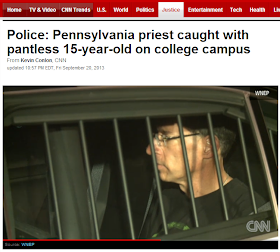1) Like theistic evolution and old-earth creationism, young-earth creationism is prepackaged. Off the top of my head, these are typical elements:
i) God made the world in 6 consecutive calendar days.
ii) The universe is 6-10K years old.
iii) God made all the natural kinds ex nihilo during that one-week timespan.
iv) God directly created Adam and Eve.
v) Adam and Eve were the first humans.
vi) The flood was global
vii) Animal mortality, predation, parasitism, and pathogens are postlapsarian and/or postdiluvian developments.
Young-earth creationists disagree on whether the Genesis genealogies are open or closed. But even if they are open, that only allows for another roughly 4000 years.
2) I'd like to focus on (vii). This generates internal tensions for YEC.
i) YECs are ambivalent on the timing of carnivory. Is this postlapsarian or postdiluvian? On the one hand, they appeal to the cursed snake and the cursed ground (Gen 3). That would make it postlapsarian. On the other hand, they appeal to the permission to eat meat (Gen 9). That would make it postdiluvian.
ii) The appeal to the cursed snake is exegetically dubious. In the cultural context, this probably distinguishes a venomous snake in a striking position from a venomous snake in a docile position.
Likewise, the cursed ground probably distinguishes the hospitable conditions inside the garden in stark from the inhospitable conditions outside the garden.
ii) They appeal to the golden-age passages in Isa 11 and 65. However, many young-earth creationists are dispensationalists. They think these Isaian passages refer to the Millennium. Yet mortality is still in force during the Millennium. Presumably, that includes death by "natural causes," viz., disease, old age.
iii) Likewise, they extrapolate from passages referring to human mortality to animal mortality. But that ironically reflects an evolutionary outlook, where humans and animals range along a common continuum. By contrast, Gen 1-2 clearly distinguishes humans from animals. Although we share some physical commonalities, we enjoy privileges that animals do not.
iii) They consider predation, parasitism, &c. to be natural evils, which are inconsistent with the "goodness" of the prelapsarian creation. However, they need to show on exegetical grounds that the narrator regarded natural "evils" (a modern classification) as not good, in terms of Gen 1-2. Ironically, young-earth creationists view the problem of animal pain in much the same way as atheists (e.g. Louise Antony, Andrea Weisberger). On the face of it, that's a preconception they are bringing to Genesis rather than deriving from Genesis.
iv) They draw hairsplitting distinctions between different types of carnivores. Insects and invertebrates don't count.
v) They are ambivalent on what changes occurred. Sarfati says:
The Bible doesn't specifically explain how carnivory originated, but since creation was finished after Day 6 (Gen 2:1-3), there is no possibility that God later created new carnivorous animals (The Greatest Hoax on Earth, 288).
That's a key distinction–distinguishing fiat creationism from progressive creationism or theistic evolution.
He seems to allow for predatory equipment like claws and venom to be preexisting features ("predesigned") which either weren't used before the Fall, or were used for something else (289-90).
On the other hand, he also says God programmed creatures with genetic information that was switched on after the Fall (290). And he talks about embryology (290). So perhaps he believes prelapsarian creatures didn't have the preexisting predatory apparatus. Rather, they had the genetic program. After the Fall, God flipped the switch, so that for the first time some animals began to develop these features during gestation and maturation. It's hard to make out his precise position.
Likewise, Snelling suggests this could have been preexisting equipment which wasn't used for predation (Earth's Catastrophic Past, 1:239). On the other hand, he says:
Such structures as fangs and claws could have been the result of the expression of recessive features which only became dominant due to selection processes later, or were mutational features following the Curse instead of originally created equipment.
These would have included genetic changes so that its descendants would also henceforth slither on their bellies…if God chose to make design and genetic changes to the serpent.
God may have flipped some "genetic switches" present in His original design that caused these changes to appear immediately…If God used such genetic switches to cause physical changes in some plants in response to the Curse…then perhaps teeth in the mouths and nails on the feet of animals designed for herbivorous diet transformed into fangs and claws respectively…Similarly, it is possible that bacteria and other microorganisms…also underwent genetic changes (1:239, 254, 256).
The problem with this explanation is that it becomes a second creation. Young-earth creationists espousing postlapsarian (or postdiluvian) theistic macroevolution. Isn't the definition of macroevolution the development of novel morphology (e.g. new body parts and body plans) in response to new genetic information?
vi) The argument suffers from additional problems. They appeal to examples of carnivores which can survive on vegetation. But that's very selective. Sure, there are exceptions. Some carnivores which normally prefer meat are actually omnivorous in a pinch.
But that doesn't work for creatures whose digestive system is essentially carnivorous or even hematophagous, viz., anteaters, jellyfish, vampire bats. To retrofit them from herbivores to carnivores requires macroevolution, kinda like those transformation scenes where humans turn into werewolves.
vii) For some odd reason, they think it would be morally impermissible for God to allow predation before the Fall, but morally permissible for God to allow predation after the Fall. The distinction is ad hoc.










